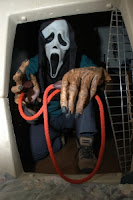Imagine someone you trust getting out one of your favorite things (the leash) and then putting you into a big metal box (the car). Sometimes this ends up bringing you to good things (dog park) but every once in awhile you end up going somewhere where bad things happen (the vet). If you go to the vet, there are weird smells, sounds you don't understand. They start poking and prodding you and making you hold still. You are panting and pacing and not sure what you should do. And worst of all, this person that you trust lets this happen and acts like everything is normal and you should just accept it. They try to reassure you but it still hurts and you're not sure what to expect the next time you get in that metal box.
Cat
You are sitting there minding your own business, enjoying your morning nap. Your trusted owner picks you up and stuffs you into this little box (the carrier). They take you outside where you are never allowed to go on your own and put the little box into a bigger box (the car). It feels like you are moving but you can't really see what is going on. You cry and cry, trying to get someone to get you out of this box and back where it is safe. No one responds. Finally the big box stops and you are taken into a building that has weird smells and sounds. You still are not sure what is going on but at least you have stopped moving now. You hear people talking and then the little box you are in is picked up and you are dumped out onto a cold table. You freeze in fear just hoping this will end soon. People start touching you, looking into your ears and opening your mouth and you have no idea why. Then they hold you down and start poking you with needles. Finally they let you go and all you want to do is get back home and hide.
Can you see why this could create problems with getting your pet to go into the carrier, or a car or to not like going to the vet? We can't control the whole process. It's still sometimes difficult to get cats to like their carrier and some dogs still have problems with car rides (if this is your pet let us know we have some ideas that might help). Once you get to the clinic though, we can do our best to make the visit as enjoyable as possible.
Using lots of treats can help. If your pet has a sensitive stomach or is on a special diet please let us know. We do have treats we can use for them too. You can bring special treats from home as an option as well. If your pet has been scared when they came in previously we might ask you to skip breakfast and bring it with you. A hungry dog is more likely to take a treat from us than one who just ate breakfast.
You might not realize some of the things we are doing, but something as simple as not making eye contact or turning sideways to your dog as we are greeting them can make them much more comfortable approaching us. With cats we try to take as much of a hands off approach as possible. When you get here we try to get you into an exam room right away. No sense in having a dog try to investigate what is in the carrier and really upset them. If we don't have a room available immediately, we might suggest putting them somewhere where it is a little quieter until we can get you into an exam room. We put a towel with Feliway (a calming feline pheromone) over them to try to calm them even more. The towel blocks some of the sights and sounds and Feliway has a calming effect on most cats.
Once you are in an exam room it's best to open the door to the carrier and let your cat decide whether they want to come out to investigate or not. If they don't that's OK. They feel safe where they are. We will get them out when we have to. We try to have everything ready and do things as efficiently as possible. We usually try to take the carrier apart and leave the cat in it if they don't want to come out. The less we move them the happier they are. Sometimes the only thing we need them out of the carrier for is to get a weight so we might do that last.
All animals appreciate when we respect their space and handle them in a comforting manner. Some pets are more anxious than others and for some it may be better to bring them back on a different day for the care they need and try some medication to ease their anxiety. If you feel your pet has been very anxious here in the past and want to try medication please let us know. We want to make things as easy on you and your pet as possible, and make it a safe experience for everyone involved.
Veterinary visit are vital to your pets health and well-being. Our pets don't understand what we are doing is only trying to help them. We wish we could explain to them that poke they felt wasn't us trying to be mean, it was us giving them a life saving vaccine that will protect them again deadly viruses. But with a calm gentle FEAR FREE approach we can ease some of that stress. We take the extra time and go the extra mile to make your pet feel safe, comfortable and happy!
For more information on our Fear Free Vet Visit and Low-Stress Handling you can visit our website at http://harveyanimalhospital.com/lowstress.pml

